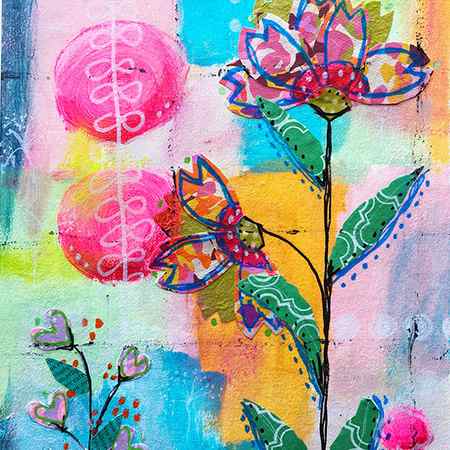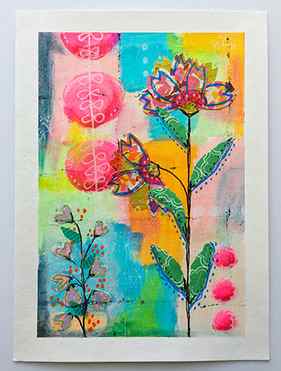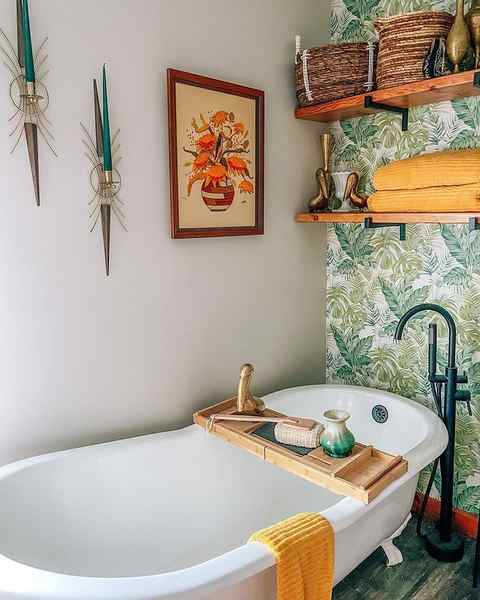Tiled bathroom walls? No problem! Even if you can’t directly nail into the wall, you can still hang art using stick-on hooks. Here, a small piece livens up an all-white bathroom
Painting Techniques that Make You Trust Your Gut
I’m guessing there is no shortage of acrylic paint in your workspace. Mine either. Since I frequently use paint in my mixed-media art I’m always looking for new painting techniques and ideas, just to make sure things don’t get stagnant. Feeling like I needed to shake up my routine, I opted for a project in the book Intuitive Painting Workshop by Alena Hennessy. My experience can be summed up in one word: Wow. My creativity has just gotten a shot of adrenaline.
Alena’s book is perfect if you feel you need to work more intuitively, which I definitely do. I sometimes get so caught up with trying to choose the perfect palette, or not messing anything up, that I fail to have faith in and enjoy the process—and that’s what mixed-media art is all about. As Alena writes, “There needs to be some letting go, and ultimately some trust needs to develop. This is when accepting and feeling akin to your inherent mark and visual voice are so valuable.”

For my project I chose “Botanical Beauty,” which explores botanical shapes and designs. Alena suggests using reference books on flowers for inspiration, and I researched botanical prints to get some ideas for floral motifs and composition.
For the background layer, I masked off a border on 11″ x 14″ 140-lb. watercolor paper and painted blocks of color with a foam brush, with no pre-planned palette in mind. This was incredibly freeing, and I took a deep breath, let go of control, and trusted that everything would work out. I instantly loved this layer. Even though the painting techniques were simple, they produced a strong foundation.

When the paint was dry, I cut flowers and leaves from colorful handmade papers and arranged and glued them on the background, building my composition. I had to stop myself from overthinking this part, too, and just went with what felt right. I created one main flower and one little flower-plant thing, leaving areas for more painting later.

With the piece before me at this stage, I really had to trust the process—and myself—as I added more paint layers with paint pens and acrylics. This would usually be the time I’d reach for a stencil or a stamp to add some designs. While there’s nothing wrong with that, this time I wanted to go without. Using fluorescent pink paint, I created two series of circles, and embellished the petals and leaves with various colors of acrylic paint pens.

There were also a few things I didn’t do: I didn’t rush the piece. When I felt frustrated or not sure where to go next, I took a break and put it away. Looking at it with fresh eyes, I was confident about what to do next. I also didn’t hold back from trying different painting techniques to add interest. One of the great things about Intuitive Painting Workshop is the gallery of artwork that follows each project. I’m a firm believer in borrowing ideas and making them your own, and I did that here, drawing motifs, shading, and adding marks with the end of a paintbrush and the paint pens. Glazing medium was added to light and dark shades of paint to make it more translucent, and I spread it across areas with a brush and my fingers, incorporating a variety of values.
I also added water-soluble Gelatos, which offered even more translucent color. Doing all of that made me appreciate the versatility of acrylic paint, and how many painting techniques and layers you can incorporate in one piece without overwhelming it.
I love how the finished piece came out, and I can’t wait to get started on another one. One more bonus: the book includes a list of art terms, and Alena explains concepts such as perspective and rhythm in ways that are understandable, allowing you to incorporate them easily into your work.

Here’s a quick bonus project that I learned from Rae Missigman: Scan your art and print it out on a sticker sheet, then use parts of it for other artwork, like cards, collage, and art journal pages. I punched a circle and used it for a unique envelope seal.

I hope you find as much joy in the process (and in your finished artwork) as I have. Just remember to listen to your inner voice!
There are a lot more great painting techniques to discover. Try this fun method with watercolor, from Gina Rossi Armfield!
Try a Petite Picture

Tiled bathroom walls? No problem! Even if you can’t directly nail into the wall, you can still hang art using stick-on hooks. Here, a small piece livens up an all-white bathroom
02 of 20
Make Use of a Floating Shelf

Many people have floating or open shelving somewhere in their bathroom, and this can be a great place to display small framed artwork, particularly if you like to change things out often. You can even layer a few different frames for a chic, collected look.
03 of 20
Light It Up With Candle Sconces

How fun are these gold candle holders? Add a touch of glam to your bathroom with an addition like this one. After all, who doesn’t want to bathe by candlelight after a long day? Add in some bright-colored taper candles for a little extra pizzazz.
04 of 20





